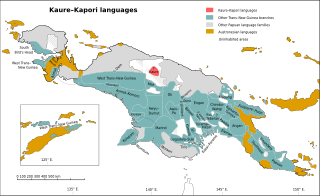Related Research Articles

The Papuan languages are the non-Austronesian and non-Australian languages spoken on the western Pacific island of New Guinea in Indonesia and Papua New Guinea, as well as neighbouring islands, by around 4 million people. It is a strictly geographical grouping, and does not imply a genetic relationship. The concept of Papuan (non-Austronesian) speaking Melanesians as distinct from Austronesian-speaking Melanesians was first suggested and named by Sidney Herbert Ray in 1892.
The Sko or Skou languages are a small language family spoken by about 7000 people, mainly along the Vanimo coast of Sandaun Province in Papua New Guinea, with a few being inland from this area and at least one just across the border in the Indonesian province of Papua.

The West Papuan languages are a proposed language family of about two dozen non-Austronesian languages of the Bird's Head Peninsula of far western New Guinea, the island of Halmahera and its vicinity, spoken by about 220,000 people in all. It is not established if they constitute a proper linguistic family or an areal network of genetically unrelated families.

The Mantion–Meax or (South)East Bird's Head languages are a language family of three languages in the "Bird's Head Peninsula" of western New Guinea, spoken by all together 20,000 people.

Stephen Adolphe Wurm was a Hungarian-born Australian linguist.

The Yawa languages, also known as Yapen languages, are a small family of two closely related Papuan languages, Yawa and Saweru, which are often considered to be divergent dialects of a single language. They are spoken on central Yapen Island and nearby islets, in Cenderawasih Bay, Indonesian Papua, which they share with the Austronesian Yapen languages.
Sougb, or Sogh, is a Papuan language of the East Bird's Head language family spoken in the east of the Bird's Head Peninsula to the east of Meyah and to the south of Manokwari, including the area of Soug Jaya District, Teluk Wondama Regency. It consists of four dialects and is spoken by around 12,000 people in all. The language is alternatively known as Mantion, or Manikion, an originally derogatory term used by the Biak people.

The Kaure–Kosare or Nawa River languages are a small family spoken along the Nawa River in West Papua, near the northern border with Papua New Guinea. The languages are Kaure and Kosare.

The Mek languages are a well established family of Papuan languages spoken by the Mek peoples. They form a branch of the Trans–New Guinea languages (TNG) in the classifications of Stephen Wurm (1975) and of Malcolm Ross (2005).

The Gogodala–Suki or Suki – Aramia River languages are a small language family of Papua New Guinea, spoken in the region of the Aramia River. The four language are clearly related.

The Sepik Hill languages form the largest and most ramified branch of the Sepik languages of northern Papua New Guinea. They are spoken along the southern margin of the Sepik floodplain in the foothills of Central Range of south-central East Sepik Province.
The Demta–Sentani languages form a language family of coastal Indonesian Papua near the Papua New Guinea border.
West Bird's Head languages are a small family of poorly documented Papuan languages spoken on the Bird's Head Peninsula of New Guinea.
Mpur, is a language isolate spoken in and around Mpur and Amberbaken Districts in Tambrauw Regency of the Bird's Head Peninsula, New Guinea. It is not closely related to any other language, and though Ross (2005) tentatively assigned it to the West Papuan languages, based on similarities in pronouns, Palmer (2018), Ethnologue, and Glottolog list it as a language isolate.
Hatam is a divergent language spoken on the island of New Guinea, specifically in the Indonesian province of West Papua.
Abun, also known as Yimbun, Anden, Manif, or Karon Pantai, is a Papuan language spoken by the Abun people along the northern coast of the Bird's Head Peninsula in Sausapor District, Tambrauw Regency. It is not closely related to any other language, and though Ross (2005) assigned it to the West Papuan family, based on similarities in pronouns, Palmer (2018), Ethnologue, and Glottolog list it as a language isolate.
Molof is a poorly documented Papuan language spoken by about 200 people in Molof village, Senggi District, Keerom Regency.
Darrell T. Tryon was a New Zealand-born linguist, academic, and specialist in Austronesian languages. Specifically, Tryon specialised in the study of the languages of the Pacific Islands, particularly Vanuatu, the Solomon Islands, and the French-speaking Pacific.
Clemens Lambertus Voorhoeve is a Dutch linguist who specializes in Papuan languages.
Tom Dutton was an Australian linguist specialising in Papuan languages and other languages of Papua New Guinea.
References
- ↑ Felicity Meakins, Jennifer Green, Myfany Turpin (2018). Understanding Linguistic Fieldwork. Routledge. ISBN 978-1-351-33010-7.
{{cite book}}: CS1 maint: multiple names: authors list (link) - 1 2 Jelle Miedema, Ger P. Reesink (2004). One Head, Many Faces: New Perspectives on the Bird's Head Peninsula of New Guinea. KITLV Press. ISBN 978-90-6718-229-4.
- 1 2 G. Reesink (2006). "West Papuan Languages". Encyclopedia of Language & Linguistics. Elsevier. pp. 555–558. doi:10.1016/b0-08-044854-2/04602-2. ISBN 978-0-08-044854-1 . Retrieved 2020-01-13.